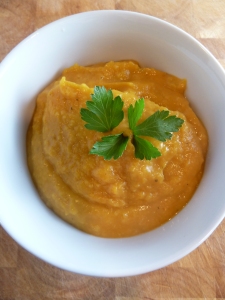I have never met anyone who doesn’t like butternut squash soup. Really, I never have. Even picky eaters will happily gobble it up. I happen to love it, too, and there is nothing like the smell of carmelizing squash to make your stomach rumble.
The thing that is great about this soup is that it is so versatile– it can be a starter for an Autumnal-themed meal, or can be the main dish itself. You can spice it up with anything you like, (omit the curry powder, perhaps, or add mint or cilantro or even thai basil). You can make it vegan by using just the coconut milk and some water, or you can add chicken stock if you like. You can use pears instead of the apples, or acorn/kubota squash. So many possibilities! And of course it is delicious just as is.
Butternut Squash Soup with Ginger and Apples
Adapted From Ina Garten
2 tbs unsalted butter
2 tbs good olive oil
1 2-inch piece fresh ginger, grated
4 cups chopped yellow onions (3 large)
2 tablespoons mild curry powder
5 pounds butternut squash (2 large)
1 1/2 pounds sweet apples, such as McIntosh (4 apples)
2 teaspoons kosher salt
1/2 teaspoon freshly ground black pepper
2 cups water (or coconut milk, which is what I used)
2 cups good apple cider or juice
Warm the butter, olive oil, onions, and curry powder in a large stockpot uncovered over low heat for 15 to 20 minutes, until the onions are tender. Stir occasionally, scraping the bottom of the pot.
Peel the squash, cut in half, and remove the seeds. Cut the squash into chunks. Peel, quarter, and core the apples. Cut into chunks.
Add the squash, apples, ginger, salt, pepper, and 2 cups of water to the pot. Bring to a boil, cover, and cook over low heat for 30 to 40 minutes, until the squash and apples are very soft. Process the soup through a food mill fitted with a large blade, or puree it coarsely in the bowl of a food processor fitted with a steel blade.
Pour the soup back into the pot. Add the apple cider or juice and enough water to make the soup the consistency you like; it should be slightly sweet and quite thick. Check the salt and pepper and serve hot.






